Experimental Evaluation of Pedestrian-Induced Multiaxial Gait Loads on Footbridges: Effects of the Structure-to-Human Interaction by Lateral Vibrating Platforms
Abstract
:1. Introduction
2. Experimental Methods
2.1. Investigation General Design
2.2. Subjects of the Test
2.3. Assembly Setup
2.4. Data Collection Procedures
2.5. Data Post-Processing
2.6. HSI-MTF Lateral-Load Verification System
3. Results and Discussion
3.1. Support and Swing Phase Periods of the Human Gait
3.2. Assessment of Human Gait-Induced Loads
3.2.1. Lateral Load
3.2.2. Vertical Load
3.3. Correlation between CM and Treadmill Movements
4. Conclusions
Author Contributions
Funding
Institutional Review Board Statement
Informed Consent Statement
Data Availability Statement
Conflicts of Interest
References
- Andrade, P.; Santos, J.; Maia, L. Numerical methods to predict human induced vibrations on low frequency stairs. Part 1, Literature review, modelling. Structures 2021, 34, 575–588. [Google Scholar] [CrossRef]
- Andrade, P.; Santos, J.; Escórcio, P. Numerical methods to predict human induced vibrations on low frequency stairs. Part 2, Evaluation by comparing with experimental data. Structures 2021, 34, 1008–1020. [Google Scholar] [CrossRef]
- Ellis, B.R.; Ji, T. Human-structure interaction in vertical vibrations. In Proceedings of the Institution of Civil Engineers—Structures and Buildings; ICE Publishing: London, UK, 1997; Volume 122, pp. 1–9. [Google Scholar]
- Ortiz, A.R.; Gómez, D.; Thomson, P. Caracterización del efecto de la interacción Humano-Estructura en el Estadio Olímpico en Cali, Colombia. Ing. Investig. 2009, 29, 13–23. [Google Scholar] [CrossRef]
- Mohammed, A.; Pavic, A. Human-structure dynamic interaction between building floors and walking occupants in vertical direction. Mech. Syst. Signal Process. 2021, 147, 107036. [Google Scholar] [CrossRef]
- Moreu, F.; Maharjan, D.; Zhu, C.; Wyckoff, E. Monitoring Human Induced Floor Vibrations for Quantifying Dance Moves: A Study of Human–Structure Interaction. Front. Built Environ. 2020, 6, 36. [Google Scholar] [CrossRef]
- Živanović, S. Benchmark Footbridge for Vibration Serviceability Assessment under the Vertical Component of Pedestrian Load. J. Struct. Eng. 2012, 138, 1193–1202. [Google Scholar] [CrossRef]
- van den Broeck, P.; van Hauwermeiren, J.; van Nimmen, K. An open access benchmark dataset on pedestrian-induced vibrations collected on the eeklo footbridge. In Proceedings of the International Conference on Structural Dynamic, EURODYN, Athens, Greece, 23–26 November 2020; Volume 1, pp. 1866–1873. [Google Scholar] [CrossRef]
- Van Nimmen, K.; Van Hauwermeiren, J.; Van den Broeck, P. Eeklo Footbridge: Benchmark Dataset on Pedestrian-Induced Vibrations. J. Bridge Eng. 2021, 26, 05021007. [Google Scholar] [CrossRef]
- Fujino, Y.; Pacheco, B.M.; Nakamura, S.; Warnitchai, P. Synchronization of human walking observed during lateral vibration of a congested pedestrian bridge. Earthq. Eng. Struct. Dyn. 1993, 22, 741–758. [Google Scholar] [CrossRef]
- Brownjohn, J.; Fok, P.; Roche, M.; Moyo, P. Long span steel pedestrian bridge at Singapore Changi Airport—Part 1: Prediction of vibration serviceability problems. Struct. Eng. 2004, 82, 21–27. [Google Scholar]
- Brownjohn, J.; Fok, P.; Roche, M.; Omenzetter, P. Long span steel pedestrian bridge at Singapore Changi Airport. Part 2: Crowd loading tests and vibration mitigation measures. Struct. Eng. 2004, 82, 28–34. [Google Scholar]
- Dallard, P.; Fitzpatrick, A.J.; Flint, A.; Le Bourva, S.; Low, A.; Ridsdill Smith, R.M.; Willford, M. The London millennium footbridge. Struct. Eng. 2001, 79, 17–21. [Google Scholar]
- Caetano, E.; Cunha, Á.; Magalhães, F.; Moutinho, C. Studies for controlling human-induced vibration of the Pedro e Inês footbridge, Portugal. Part 1: Assessment of dynamic behaviour. Eng. Struct. 2010, 32, 1069–1081. [Google Scholar] [CrossRef]
- Caetano, E.; Cunha, Á.; Moutinho, C.; Magalhães, F. Studies for controlling human-induced vibration of the Pedro e Inês footbridge, Portugal. Part 2: Implementation of tuned mass dampers. Eng. Struct. 2010, 32, 1082–1091. [Google Scholar] [CrossRef]
- Živanović, S.; Pavić, A. Quantification of dynamic excitation potential of pedestrian population crossing footbridges. Shock Vib. 2011, 18, 563–577. [Google Scholar] [CrossRef]
- Živanović, S.; Pavic, A.; Reynolds, P. Vibration serviceability of footbridges under human-induced excitation: A literature review. J. Sound Vib. 2005, 279, 1–74. [Google Scholar] [CrossRef]
- Zhu, Q.; Yang, W.; Zhang, Q.; Du, Y. A hybrid vibration mitigation method based on the crowd flow control and tuned mass damper on a footbridge. Eng. Struct. 2021, 245, 112972. [Google Scholar] [CrossRef]
- Zhu, Q.; Yang, W.; Du, Y.; Živanović, S. Investigation of a vibration mitigation method based on crowd flow control on a footbridge. Structures 2021, 33, 1495–1509. [Google Scholar] [CrossRef]
- Gomez, D.; Dyke, S.J.; Rietdyk, S. Structured uncertainty for a pedestrian-structure interaction model. J. Sound Vib. 2020, 474, 115237. [Google Scholar] [CrossRef]
- Lai, E.; Mulas, M.G. A MSD model for coupled analysis of pedestrian-footbridge dynamic interaction. In Procedia Engineering; Elsevier: Amsterdam, The Netherlands, 2017; Volume 199, pp. 2864–2870. [Google Scholar] [CrossRef]
- Strogatz, S.H.; Abrams, D.M.; McRobie, A.; Eckhardt, B.; Ott, E. Theoretical mechanics: Crowd synchrony on the Millennium Bridge. Nature 2005, 438, 43–44. [Google Scholar] [CrossRef]
- Eckhardt, B.; Ott, E.; Strogatz, S.H.; Abrams, D.M.; McRobie, A. Modeling walker synchronization on the Millennium Bridge. Phys. Rev. E 2007, 75, 021110. [Google Scholar] [CrossRef]
- Roberts, T.M. Lateral pedestrian excitation of footbridges. J. Bridge Eng. 2005, 10, 107–112. [Google Scholar] [CrossRef]
- Živanović, S.; Pavic, A.; Reynolds, P. Human-structure dynamic interaction in footbridges. Proc. Inst. Civ. Eng. Bridge Eng. 2005, 158, 165–177. [Google Scholar] [CrossRef]
- Shahabpoor, E.; Pavic, A.; Racic, V. Interaction between Walking Humans and Structures in Vertical Direction: A Literature Review. Shock Vib. 2016, 2016, 3430285. [Google Scholar] [CrossRef]
- Wolmuth, B.; Surtees, J. Crowd-related failure of bridges. In Proceedings of the Institution of Civil Engineers—Civil Engineering; Thomas Telford Ltd.: London, UK, 2003; Volume 156, pp. 116–123. [Google Scholar]
- Stevenson, R. Description of bridges of suspension. Edin. Philos. J. 1821, V, 237–256. [Google Scholar]
- Dziuba, P.; Grillaud, G.; Flamand, O.; Sanquier, S.; Tétard, Y. La passerelle Solférino comportement dynamique (dynamic behaviour of the Solférino bridge). Bull. Ouvrages Mét. 2001, 1, 34–57. [Google Scholar]
- Sun, L.; Yuan, X. Study on pedestrian-induced vibration of footbridge. In Proceedings of the Third International Conference Footbridge, Porto, Portugal, 2–4 July 2008. [Google Scholar]
- Bursi, O.; Zasso, A.; Bonelli, A.; Vulcan, L.; Bonora, M.; Santini, S. Dynamic Analysis and Vibration Control of the Twin Deck Curved Suspension Foot/Cycle Bridge “Ponte Del Mare”. In Proceedings of the Third International Conference Footbridge, Porto, Portugal, 2–4 July 2008; pp. 1–7. [Google Scholar]
- Ainsworth, I.D.; Burnton, P.A. More than just a pedestrian link—The Goodwill Bridge, Brisbane. In Proceedings of the Fifth Austroads Bridge Conference, Hobart, TAS, Australia, 19–24 May 2004. [Google Scholar]
- Colmenares, D.; Costa, G.; Civera, M.; Surace, C.; Karoumi, R. Quantification of the human–structure interaction effect through full-scale dynamic testing: The Folke Bernadotte Bridge. Structures 2023, 55, 2249–2265. [Google Scholar] [CrossRef]
- Bedon, C.; Fasan, M. Reliability of field experiments, analytical methods and pedestrian’s perception scales for the vibration serviceability assessment of an in-service glass walkway. Appl. Sci. 2019, 9, 1936. [Google Scholar] [CrossRef]
- Russell, J.M.; Wei, X.; Živanović, S.; Kruger, C. Vibration serviceability of a GFRP railway crossing due to pedestrians and train excitation. Eng. Struct. 2020, 219, 110756. [Google Scholar] [CrossRef]
- Gheitasi, A.; Ozbulut, O.E.; Usmani, S.; Alipour, M.; Harris, D.K. Experimental and analytical vibration serviceability assessment of an in-service footbridge. Case Stud. Nondestruct. Test. Eval. 2016, 6, 79–88. [Google Scholar] [CrossRef]
- Schutte, W.; Sousamli, M.; Blom, C.B.M.; Attahiri, M. UHPC Pedestrian bridges and measured human induced vibrations. In High Tech Concrete: Where Technology and Engineering Meet. Proceedings of the 2017 fib Symposium, Maastricht, The Netherlands, 12–14 June 2017; Springer: Berlin/Heidelberg, Germany, 2018; pp. 1522–1529. [Google Scholar]
- Setareh, M.; Asce, M.; Gan, S. Vibration Testing, Analysis, and Human-Structure Interaction Studies of a Slender Footbridge. J. Perform. Constr. Facil. 2018, 32, 04018068. [Google Scholar] [CrossRef]
- Ingólfsson, E.T.; Georgakis, C.T.; Jönsson, J. Pedestrian-induced lateral vibrations of footbridges: A literature review. Eng. Struct. 2012, 45, 21–52. [Google Scholar] [CrossRef]
- Newland, D.E. Pedestrian excitation of bridges. Proc. Inst. Mech. Eng. Part C J. Mech. Eng. Sci. 2004, 218, 477–492. [Google Scholar] [CrossRef]
- Griffin, M.J.; Erdreich, J. Handbook of Human Vibration. J. Acoust. Soc. Am. 1991, 90, 2213. [Google Scholar] [CrossRef]
- Tubino, F. Probabilistic assessment of the dynamic interaction between multiple pedestrians and vertical vibrations of footbridges. J. Sound Vib. 2018, 417, 80–96. [Google Scholar] [CrossRef]
- Wei, X.; Liu, J.C.; Bi, S. Uncertainty quantification and propagation of crowd behaviour effects on pedestrian-induced vibrations of footbridges. Mech. Syst. Signal Process. 2022, 167, 108557. [Google Scholar] [CrossRef]
- Shahabpoor, E.; Pavic, A.; Racic, V.; Zivanovic, S. Effect of group walking traffic on dynamic properties of pedestrian structures. J. Sound Vib. 2017, 387, 207–225. [Google Scholar] [CrossRef]
- Racic, V.; Brownjohn, J.M.W. Stochastic model of near-periodic vertical loads due to humans walking. Adv. Eng. Inform. 2011, 25, 259–275. [Google Scholar] [CrossRef]
- Carroll, S.P.; Owen, J.S.; Hussein, M.F.M. A coupled biomechanical/discrete element crowd model of crowd-bridge dynamic interaction and application to the Clifton Suspension Bridge. Eng. Struct. 2013, 49, 58–75. [Google Scholar] [CrossRef]
- Chen, Z.; Chen, S.; Ye, X.; Zhou, Y. A study on a mechanism of lateral pedestrian-footbridge interaction. Appl. Sci. 2019, 9, 5257. [Google Scholar] [CrossRef]
- Lievens, K.; Lombaert, G.; Van Nimmen, K.; De Roeck, G.; Van den Broeck, P. Robust vibration serviceability assessment of footbridges subjected to pedestrian excitation: Strategy and applications. Eng. Struct. 2018, 171, 236–246. [Google Scholar] [CrossRef]
- Van Nimmen, K.; Pavic, A.; Van den Broeck, P. A simplified method to account for vertical human-structure interaction. Structures 2021, 32, 2004–2019. [Google Scholar] [CrossRef]
- Bocian, M.; Brownjohn, J.M.W.; Racic, V.; Hester, D.; Quattrone, A.; Gilbert, L.; Beasley, R. Time-dependent spectral analysis of interactions within groups of walking pedestrians and vertical structural motion using wavelets. Mech. Syst. Signal Process. 2018, 105, 502–523. [Google Scholar] [CrossRef]
- Wang, H.; Zhang, Z.; Chen, J. Prediction of structural responses induced by single-person jumping through a physical principle based on transfer functions. Adv. Struct. Eng. 2022, 25, 146–157. [Google Scholar] [CrossRef]
- Ahmadi, E.; Caprani, C.; Živanović, S.; Heidarpour, A. Vertical ground reaction forces on rigid and vibrating surfaces for vibration serviceability assessment of structures. Eng. Struct. 2018, 172, 723–738. [Google Scholar] [CrossRef]
- Ahmadi, E.; Caprani, C.; Živanović, S.; Heidarpour, A. Experimental validation of moving spring-mass-damper model for human-structure interaction in the presence of vertical vibration. Structures 2021, 29, 1274–1285. [Google Scholar] [CrossRef]
- Van Nimmen, K.; Lombaert, G.; De Roeck, G.; Van den Broeck, P. The impact of vertical human-structure interaction on the response of footbridges to pedestrian excitation. J. Sound Vib. 2017, 402, 104–121. [Google Scholar] [CrossRef]
- Berardengo, M.; Drago, L.; Manzoni, S.; Vanali, M. An approach to predict human–structure interaction in the case of staircases. Arch. Appl. Mech. 2019, 89, 2167–2191. [Google Scholar] [CrossRef]
- Venuti, F.; Racic, V.; Corbetta, A. Modelling framework for dynamic interaction between multiple pedestrians and vertical vibrations of footbridges. J. Sound Vib. 2016, 379, 245–263. [Google Scholar] [CrossRef]
- Bocian, M.; Burn, J.F.; Macdonald, J.H.G.; Brownjohn, J.M.W. From phase drift to synchronisation—Pedestrian stepping behaviour on laterally oscillating structures and consequences for dynamic stability. J. Sound Vib. 2017, 392, 382–399. [Google Scholar] [CrossRef]
- Venuti, F.; Bruno, L.; Bellomo, N. Crowd dynamics on a moving platform: Mathematical modelling and application to lively footbridges. Math. Comput. Model. 2007, 45, 252–269. [Google Scholar] [CrossRef]
- Nakamura, S.-I.; Kawasaki, T.; Katsuura, H.; Yokoyama, K. Experimental studies on lateral forces induced by pedestrians. J. Constr. Steel Res. 2008, 64, 247–252. [Google Scholar] [CrossRef]
- Ricciardelli, F.; Pizzimenti, A.D. Lateral walking-induced forces on footbridges. J. Bridge Eng. 2007, 12, 677–688. [Google Scholar] [CrossRef]
- Ingólfsson, E.T.; Georgakis, C.T.; Ricciardelli, F.; Jönsson, J. Experimental identification of pedestrian-induced lateral forces on footbridges. J. Sound Vib. 2011, 330, 1265–1284. [Google Scholar] [CrossRef]
- Bocian, M.; Brownjohn, J.M.W.; Racic, V.; Hester, D.; Quattrone, A.; Monnickendam, R. A framework for experimental determination of localised vertical pedestrian forces on full-scale structures using wireless attitude and heading reference systems. J. Sound Vib. 2016, 376, 217–243. [Google Scholar] [CrossRef]
- Bocian, M.; Macdonald, J.H.G.; Burn, J.F.; Redmill, D. Experimental identification of the behaviour of and lateral forces from freely-walking pedestrians on laterally oscillating structures in a virtual reality environment. Eng. Struct. 2015, 105, 62–76. [Google Scholar] [CrossRef]
- Zhang, S.; Živanović, S.; Williams, G. vPERFORM: The Development of Footfall Loading Models for Human Walking on Vibrating Surfaces; School of Engineering, Newcastle University: Newcastle upon Tyne, UK, 2023. [Google Scholar]
- Castillo, B.; Arango, A.L.; Marulanda, J.; Thomson, P. Comprehensive Experimental Analysis of the Vibration Serviceability Due to Dynamic Interaction between Footbridge with Accurate Multi-Axial Dynamic Sensitivity and Human-Induced Gait Loads. Mendeley Data. 2024. Available online: https://data.mendeley.com/datasets/4w3ytxrzxt/1 (accessed on 10 January 2024).
- Pizzimenti, A.D. Analisi Sperimentale dei Meccanismi di Eccitazione Laterale delle Passerelle ad Opera dei Pedoni. Ph.D. Thesis, Department of Civil and Environmental Engineering, University of Catania, Catania, Italy, 2005. [Google Scholar]
- Yang, H.; Wu, B.; Li, J.; Bao, Y.; Xu, G. A spring-loaded inverted pendulum model for analysis of human-structure interaction on vibrating surfaces. J. Sound Vib. 2022, 522, 116727. [Google Scholar] [CrossRef]
- Vujanovic, B. Conservation laws of dynamical systems via D’Alembert’s principle. Int. J. Non-Linear Mech. 1978, 13, 185–197. [Google Scholar] [CrossRef]
- Grieve, D.W.; Gear, R.J. The relationships between length of stride, step frequency, time of swing and speed of walking for children and adults. Ergonomics 1966, 9, 379–399. [Google Scholar] [CrossRef]
- Andriacchi, T.P.; Ogle, J.A.; Galante, J.O. Walking speed as a basis for normal and abnormal gait measurements. J. Biomech. 1977, 10, 261–268. [Google Scholar] [CrossRef]
- Stenum, J.; Rossi, C.; Roemmich, R.T. Two-dimensional video-based analysis of human gait using pose estimation. PLoS Comput. Biol. 2021, 17, e1008935. [Google Scholar] [CrossRef]
- Bamberg, S.J.M.; Benbasat, A.Y.; Scarborough, D.M.; Krebs, D.E.; Paradiso, J.A. Gait analysis using a shoe-integrated wireless sensor system. IEEE Trans. Inf. Technol. Biomed. 2008, 12, 413–423. [Google Scholar] [CrossRef]
- Cao, L.; Li, J.; Frank Chen, Y.; Huang, S. Measurement and application of walking models for evaluating floor vibration. Structures 2023, 50, 561–575. [Google Scholar] [CrossRef]
- Ricciardelli, F.; Mafrici, M.; Ingólfsson, E.T. Lateral Pedestrian-Induced Vibrations of Footbridges: Characteristics of Walking Forces. J. Bridge Eng. 2014, 19, 04014035. [Google Scholar] [CrossRef]
- RFS2-CT-2007-00033; Design of Footbridges—Guidelines and Background Document. Research Found for Coal and Steel: Brussels, Belgium, 2007.
- Rønnquist, A.; Strømmen, E. Pedestrian Induced Lateral Vibrations of Slender Footbridges. Ph.D. Thesis, Department of Structural Engineering, Norwegian University of Science and Technology, Trondheim, Norway, 2005. [Google Scholar]
- Bruijn, S.M.; Meijer, O.G.; Beek, P.J.; Van Dieen, J.H. Assessing the stability of human locomotion: A review of current measures. J. R. Soc. Interface 2013, 10, 20120999. [Google Scholar] [CrossRef]
- Rabiner, L.R.; Gold, B. Theory and Application of Digital Signal Processing; Prentice-Hall: Englewood Cliffs, NJ, USA, 1975. [Google Scholar]
- Welch, P. The use of fast Fourier transform for the estimation of power spectra: A method based on time averaging over short, modified periodograms. IEEE Trans. Audio Electroacoust. 1967, 15, 70–73. [Google Scholar] [CrossRef]
- Oppenheim, A.V. Discrete-Time Signal Processing; Pearson Education: Noida, India, 1999. [Google Scholar]
- Heinemeyer, C.; Butz, C.; Keil, A.; Schlaich, M.; Goldack, A.; Trometer, S.; Lukić, M.; Chabrolin, B.; Lemaire, A.; Martin, P.-O.; et al. Design of Lightweight Footbridges for Human Induced Vibrations; European Commission—Joint Research Centre: Aachen, Germany, 2009; Volume 3. [Google Scholar]
- Sétra. Footbridges: Assessment of Vibrational Behaviour of Footbridges under Pedestrian Loading; Service d’Études Techniques des Routes et Autoroutes: Paris, France, 2006. [Google Scholar]
- Bachmann, H. Case studies of structures with man-induced vibrations. J. Struct. Eng. 1992, 118, 631–647. [Google Scholar] [CrossRef]
- Bachmann, H.; Pretlove, A.J.; Rainer, H. Dynamic forces from rhythmical human body motions. In Vibration Problems in Structures: Practical Guidelines; Birkhäuser: Basel, Switzerland, 1995. [Google Scholar]
- Varela, W.D.; Pfeil, M.S.; da Costa, N.D.P.A. Experimental Investigation on Human Walking Loading Parameters and Biodynamic Model. J. Vib. Eng. Technol. 2020, 8, 883–892. [Google Scholar] [CrossRef]
- Dong, C.Z.; Bas, S.; Catbas, F.N. Investigation of vibration serviceability of a footbridge using computer vision-based methods. Eng. Struct. 2020, 224, 111224. [Google Scholar] [CrossRef]
- Kim, A.; Kim, J.; Rietdyk, S.; Ziaie, B. A wearable smartphone-enabled camera-based system for gait assessment. Gait Posture 2015, 42, 138–144. [Google Scholar] [CrossRef]


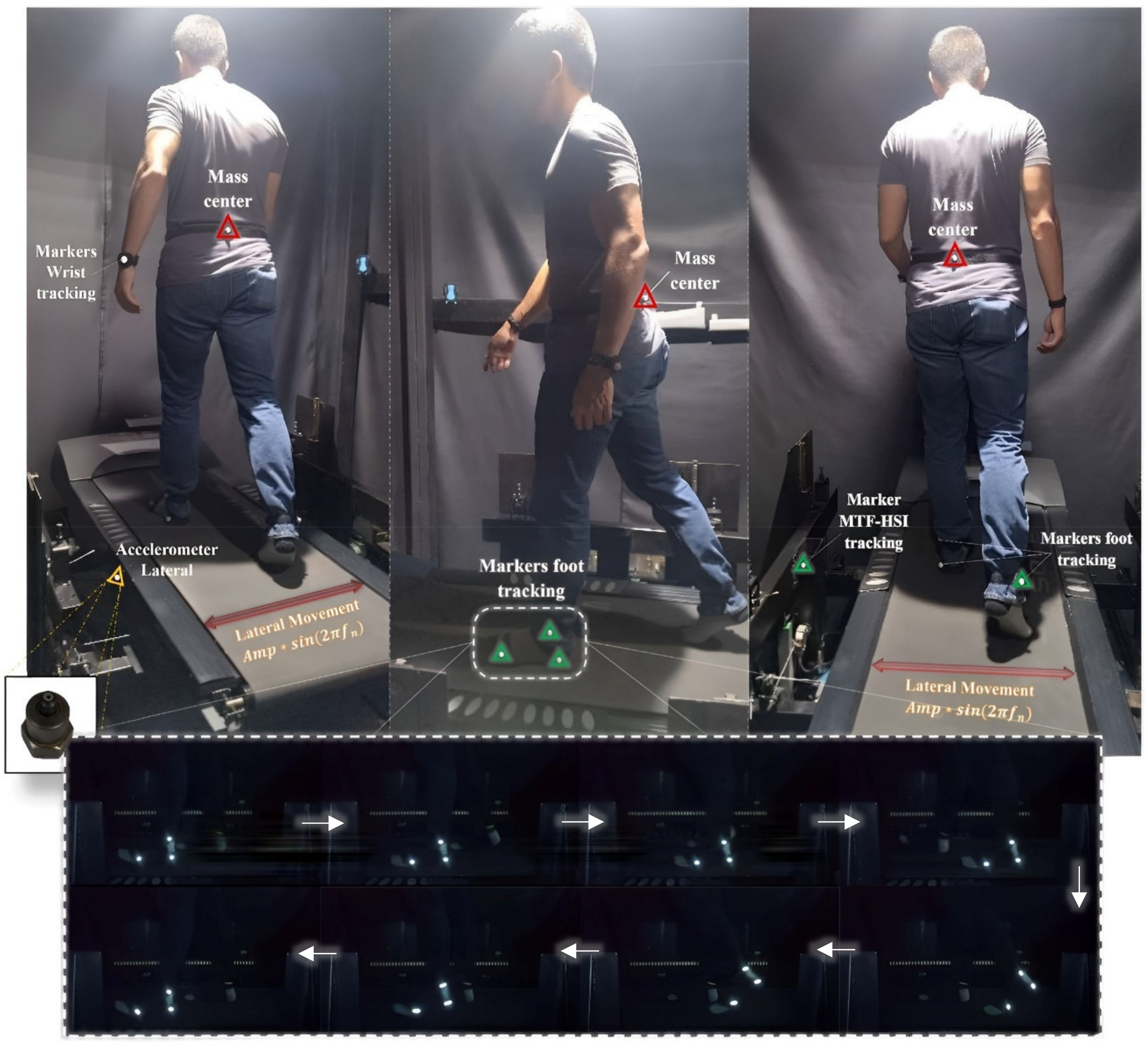



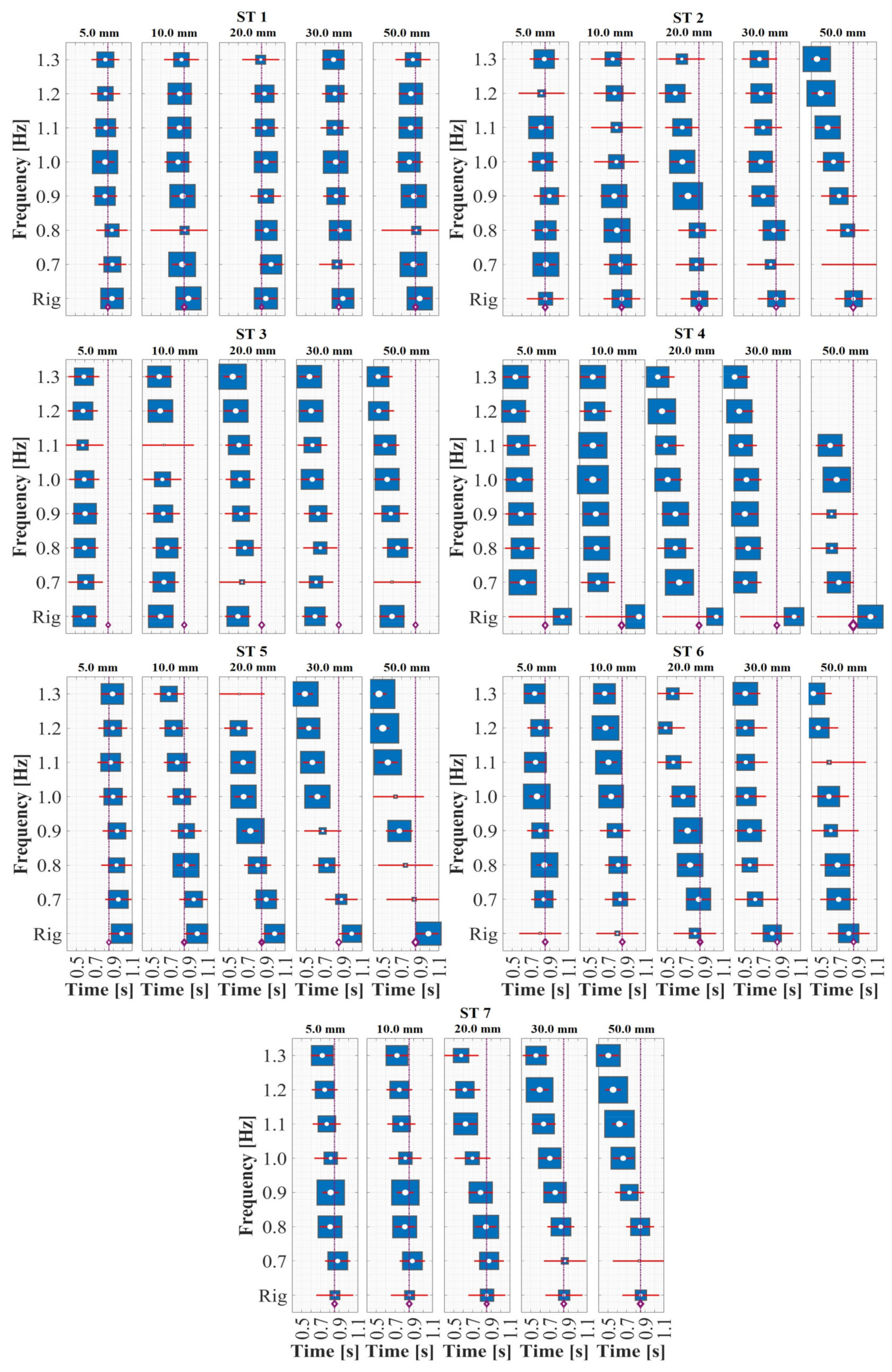
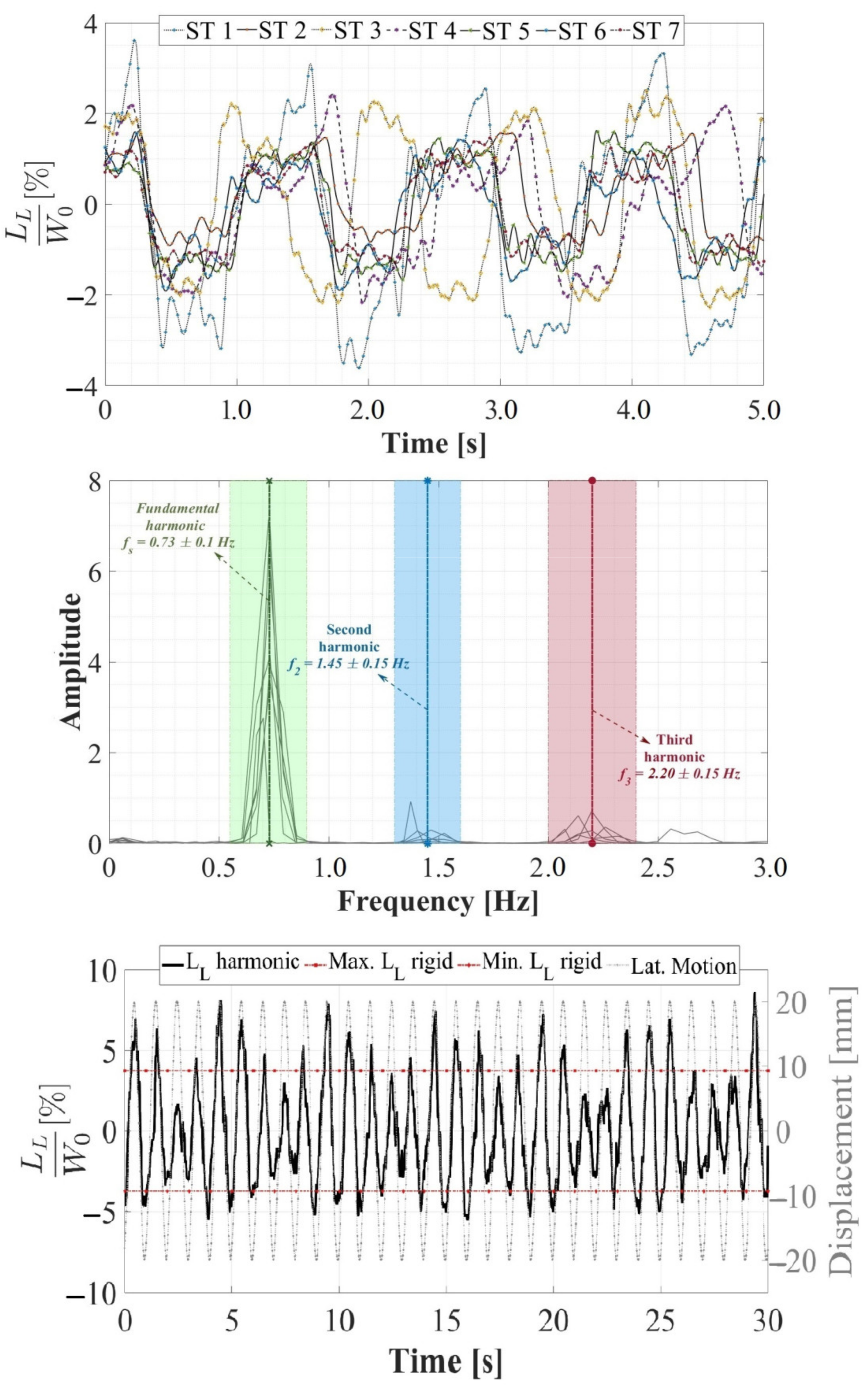
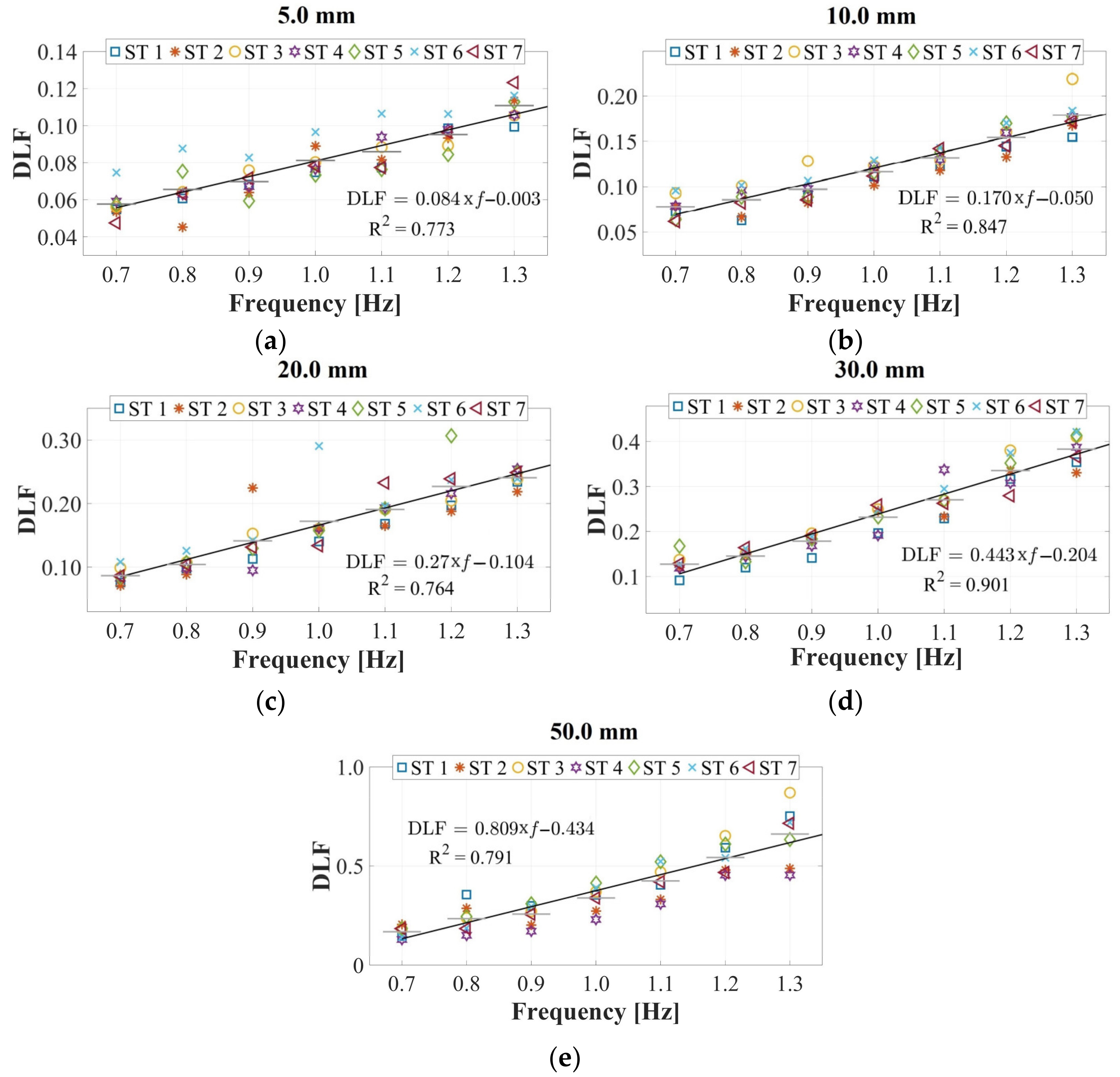
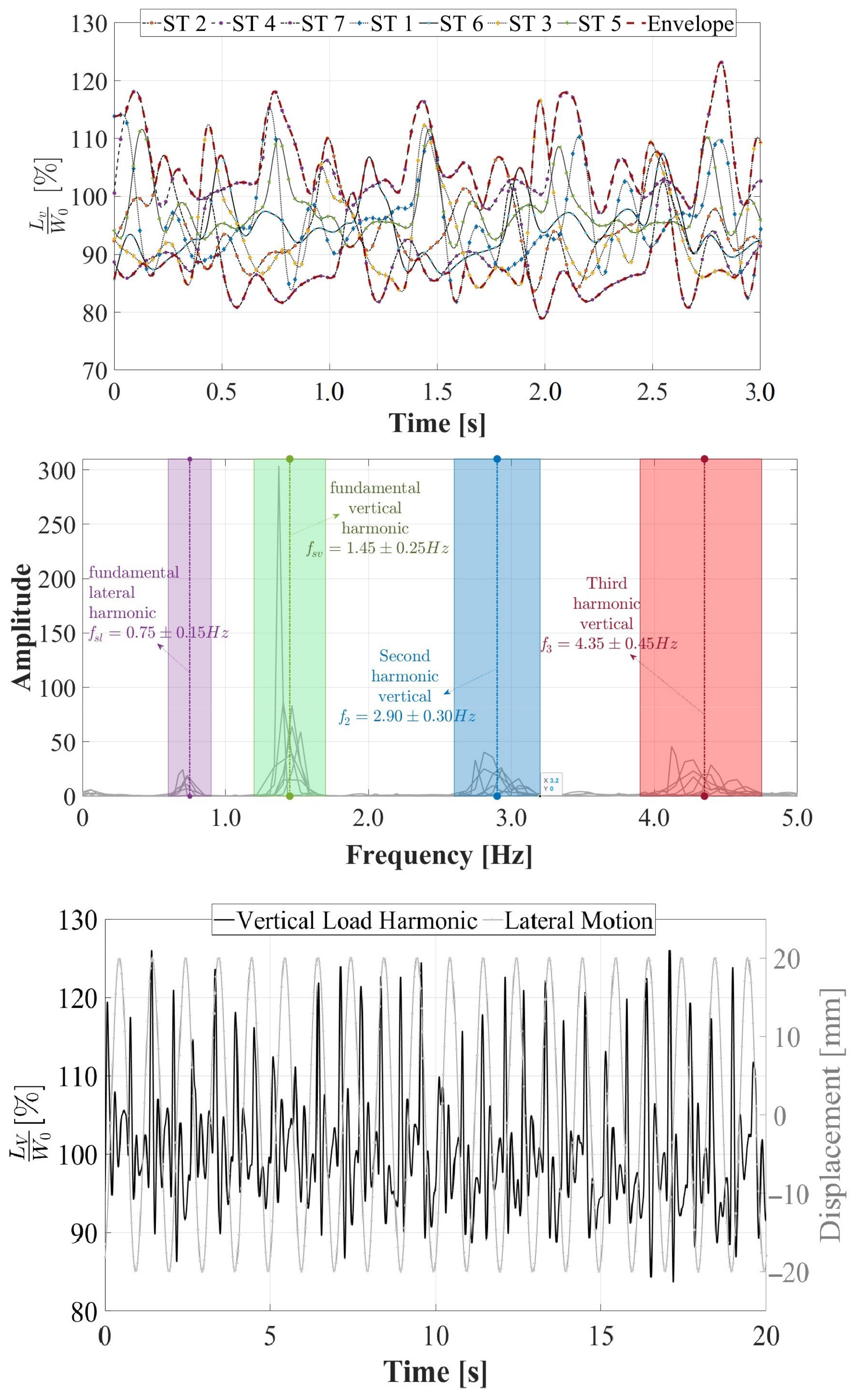

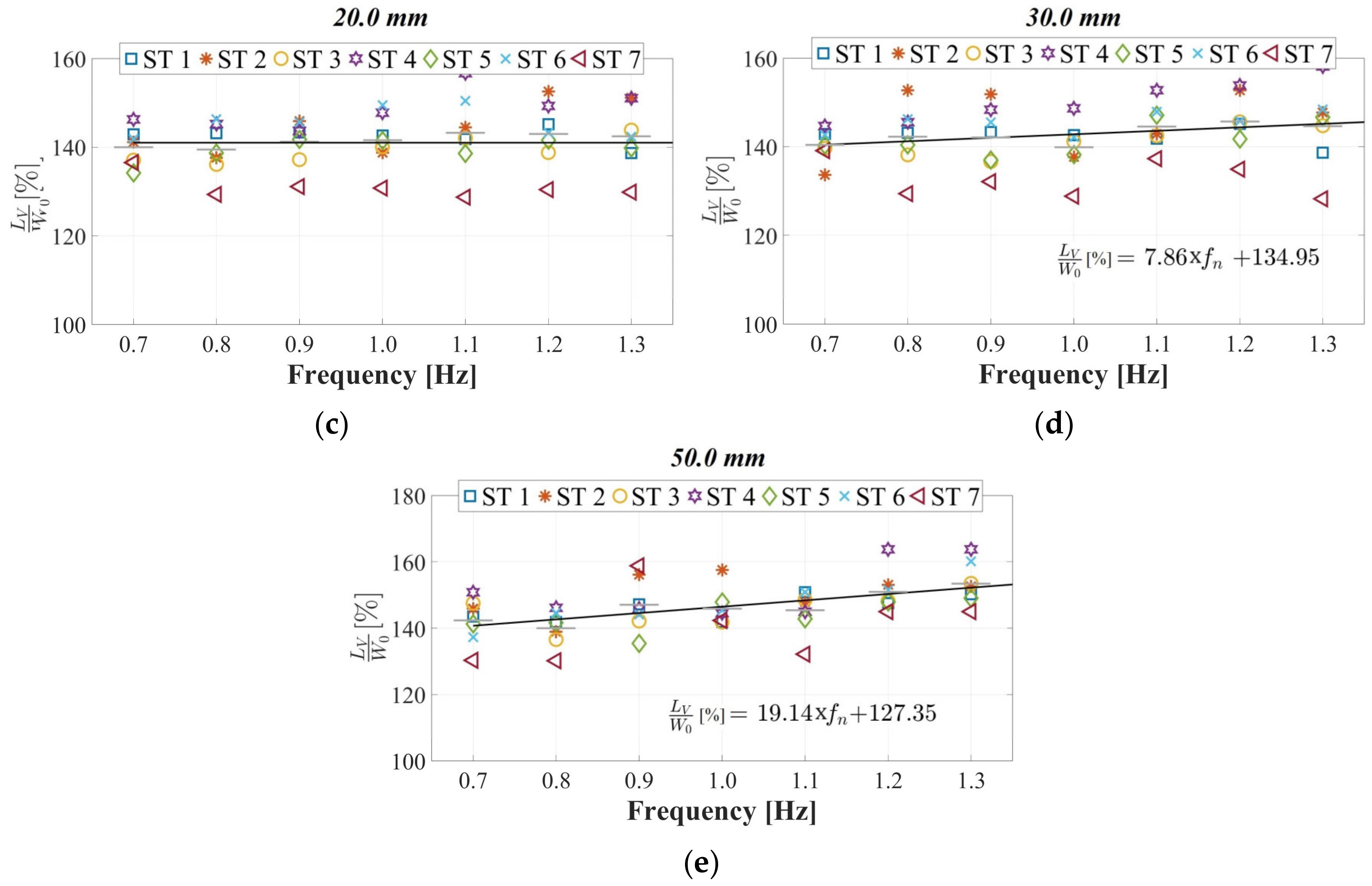
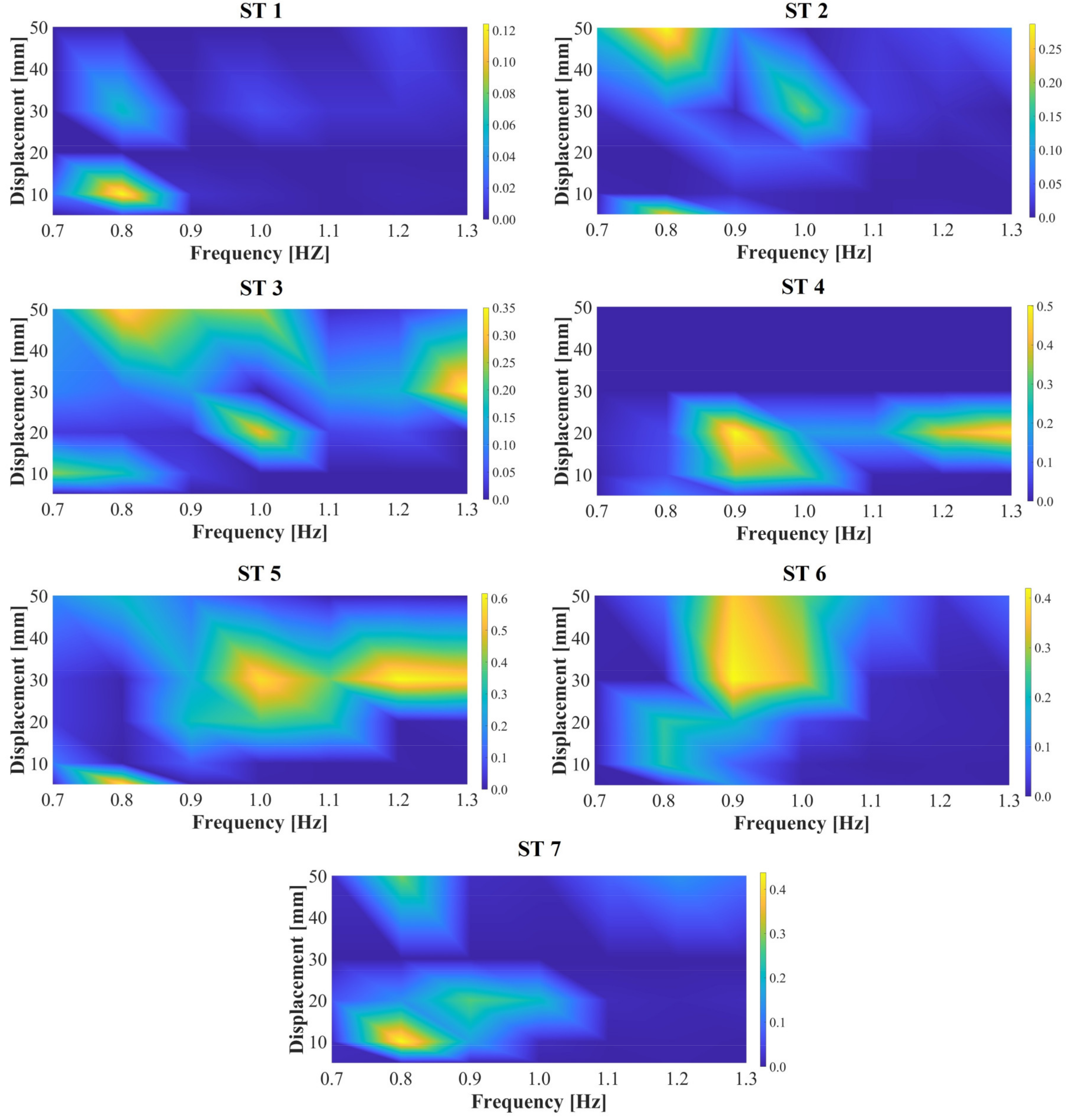
| Test Subject | ||||||||
|---|---|---|---|---|---|---|---|---|
| No. 1 | No. 2 | No. 3 | No. 4 | No. 5 | No. 6 | No. 7 | ||
| Length (cm) | D1 | 27.2 | 24.7 | 23.6 | 27.0 | 28.0 | 31.0 | 35.0 |
| D2 | 47.5 | 47.5 | 47.2 | 42.0 | 57.0 | 55.0 | 54.0 | |
| D3 | 22.3 | 19.8 | 21.7 | 20.0 | 22.0 | 20.5 | 40.0 | |
| D4 | 18.7 | 16.7 | 15.8 | 8.0 | 9.0 | 6.0 | 13.0 | |
| D5 | 31.4 | 30.6 | 30.2 | 28.0 | 30.0 | 23.0 | 27.0 | |
| D6 | 26.7 | 27.4 | 26.7 | 24.0 | 23.0 | 25.0 | 27.0 | |
| D7 | 17.7 | 19.2 | 19.8 | 19.0 | 22.0 | 17.0 | 33.0 | |
| D8 | 47.5 | 43.0 | 44.2 | 48.0 | 48.0 | 48.0 | 45.0 | |
| D9 | 46.7 | 46.5 | 45.8 | 43.0 | 43.0 | 42.0 | 41.0 | |
| D10 | 9.8 | 10.4 | 10.1 | 9.0 | 9.0 | 11.0 | 12.0 | |
| D11 | 17.5 | 15.5 | 15.2 | 15.0 | 15.0 | 15.0 | 14.0 | |
| D12 | 19.4 | 18.6 | 17.9 | 17.0 | 18.0 | 18.0 | 18.0 | |
| Diameter (cm) | Head | 57.0 | 58.0 | 54.0 | 56.0 | 56.0 | 53.0 | 58.0 |
| Shoulder | 37.0 | 47.0 | 52.0 | 35.0 | 36.0 | 37.0 | 38.0 | |
| Elbow | 25.0 | 27.5 | 28.5 | 25.5 | 27.0 | 26.5 | 27.0 | |
| Wrist | 17.0 | 16.0 | 17.0 | 16.0 | 18.0 | 16.5 | 16.0 | |
| Hip | 90.0 | 85.5 | 88.5 | 91.0 | 104.0 | 91.0 | 92.0 | |
| Knee | 38.9 | 38.5 | 41.0 | 34.5 | 43.0 | 38.5 | 36.0 | |
| Ankle | 25.0 | 24.5 | 25.0 | 26.0 | 26.0 | 23.0 | 21.0 | |
| Heel | 32.0 | 23.0 | 23.0 | 30.5 | 33.0 | 34.0 | 30.0 | |
| Metatarsus | 24.0 | 24.0 | 54.0 | 22.0 | 23.5 | 27.5 | 58.0 | |
| General Informa. | Age | 30 | 21 | 23 | 23 | 24 | 22 | 29 |
| Height (cm) | 178 | 179 | 174 | 173 | 170 | 166 | 170 | |
| Weight (kg) | 70.0 | 74.0 | 76.0 | 70.0 | 80.0 | 69.0 | 64.0 | |
| Item No. | Components Name | Description |
|---|---|---|
| 1 | Unidirectional shake table | The custom unidirectional shake table of the School of Civil and Geomatic Engineering, consists of an aluminum plate of 1.10 m × 1.50 m directed by low-friction linear rails and coupled to a Shore Western hydraulic actuator of 45.0 kN (Shore Western, Monrovia, CA, USA). This actuator has two DyVal servo-valves that are connected to a hydraulic potential of up to 977.9 cm3·s−1 at 21 MPa. In addition, it has an internal linear variable differential transducer (LVDT) that measures the position of the actuator rod. Recent work has allowed the identification of this system through frequency sweep tests from 0.10 to 20.0 Hz, with a duration of 250.0 s and constant amplitudes of 0.50, 1.0, 3.0, and 5.0 mm. A representation of the GHA plant of the seismic simulator was found to be a continuous system with a pole at the origin, a nominal gain of 14.0, and a time delay of 33.0 ms. In addition, this device was implemented with a robust H∞ displacement tracking controller conditioned by a Kalman filter. |
| 2 | Lateral support system | The lateral support system initially consisted of four custom ASTM A36 steel plates with a thickness of 1.27 cm, which were intended to increase the working area of component 1. Four lateral supports with a height of 74.0 cm were placed on top of the plates, which connected the guides of the vertical linear axes of the HSI-MTF. In addition, it supports a human gait loading acquisition system. |
| 3 | Treadmill | A SOLE brand treadmill model F65 was used (Sole Fitness, Salt Lake City, UT, USA), which has an effective action area of 72.0 cm × 150.0 cm and operating speeds ranging from 0.50 to 10.0 cm3·s−1. The forward motion is generated by a 120.0 V commercial motor controlled by the factory hardware. The treadmill was compacted and coupled with the HSI-MTF. |
| 4 | Load acquisition system | This system was developed to quantify the anthropic loads induced by human gait and consisted of a ∅1.59 mm steel wire with an ultimate load of 4.0 kN, attached to the lateral support system on the linear axes and to the bottom of the treadmill through four Omega DYLY-103 load cells (Omega Engineering, Norwalk, CT, USA) with an individual capacity of 200.0 kg and a sensitivity of 0.15 mV/kg. The vertical acquisition component was formed by a ∅3.18 mm steel wire with an ultimate load of 10.0 kN, attached to the lateral support system on the linear axes and the vertical suspension system through four Omega LC-703 load cells with a capacity of 90.70 kg each and a sensitivity of 0.20 mV/kg. Finally, the longitudinal acquisition component had the same steel wire attached to the most extreme parts of the vertical suspension system, using four Omega DYLY-102 load cells with a capacity of 50.0 kg each. |
Disclaimer/Publisher’s Note: The statements, opinions and data contained in all publications are solely those of the individual author(s) and contributor(s) and not of MDPI and/or the editor(s). MDPI and/or the editor(s) disclaim responsibility for any injury to people or property resulting from any ideas, methods, instructions or products referred to in the content. |
© 2024 by the authors. Licensee MDPI, Basel, Switzerland. This article is an open access article distributed under the terms and conditions of the Creative Commons Attribution (CC BY) license (https://creativecommons.org/licenses/by/4.0/).
Share and Cite
Castillo, B.; Marulanda, J.; Thomson, P. Experimental Evaluation of Pedestrian-Induced Multiaxial Gait Loads on Footbridges: Effects of the Structure-to-Human Interaction by Lateral Vibrating Platforms. Sensors 2024, 24, 2517. https://doi.org/10.3390/s24082517
Castillo B, Marulanda J, Thomson P. Experimental Evaluation of Pedestrian-Induced Multiaxial Gait Loads on Footbridges: Effects of the Structure-to-Human Interaction by Lateral Vibrating Platforms. Sensors. 2024; 24(8):2517. https://doi.org/10.3390/s24082517
Chicago/Turabian StyleCastillo, Bryan, Johannio Marulanda, and Peter Thomson. 2024. "Experimental Evaluation of Pedestrian-Induced Multiaxial Gait Loads on Footbridges: Effects of the Structure-to-Human Interaction by Lateral Vibrating Platforms" Sensors 24, no. 8: 2517. https://doi.org/10.3390/s24082517






